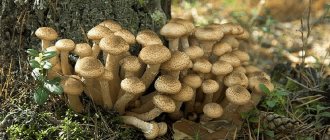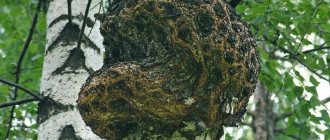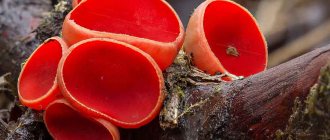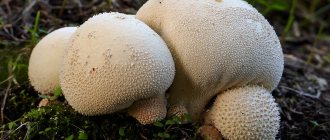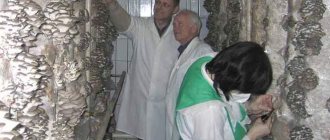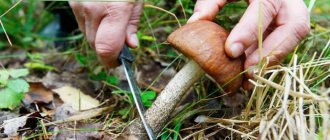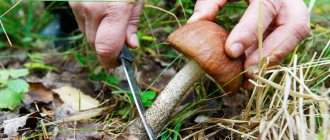Mushrooms are themselves mysterious and unusual representatives of living nature.
Not plants, not animals, just one word - mushrooms. When many people hear the word “mushrooms,” they conjure up a picture of a sturdy boletus on a stalk in the autumn leaves. However, in fact, the fungal kingdom is huge, and the types of fungi are extremely diverse. There are microscopic ones, invisible to the eye, there are huge ones, of different colors and shapes, or without any shape at all. I already wrote more about mushrooms in the article “Who are mushrooms.” But among them there are especially unusual representatives, with whom I will now introduce you. For each of us, the concept of “unusual” mushroom is relative. A long time ago, the magazine “Young Naturalist” published a story about our compatriots working under contract in Africa. There, under the planted pines, boletus appeared. To the horror of the aborigines, ours began to eat these “monsters”.
Why go far, recently a good friend of mine from another region of Ukraine struck my imagination by collecting low-grade russula for cooking. I consider such mushrooms unsuitable for my basket and attribute them to survival items when I get lost in a deep forest and don’t find food for three days :) And she collected them and said: “We have very few mushrooms, and these go great!” .
If your places are also not rich in mushrooms, you can plant them yourself - right on your own plot. Our market, where products from various online stores are presented, will help you choose mushrooms for your garden. Australian boletus mushroom on grain substrate, 15 ml 149 rub.
seedspost.ru
Cereal mycelium Ryzhik Delicacy, 30 ml 137 RUR
seedspost.ru
Mushroom Kozlyak Reshetnik on grain substrate, 15 ml 137 rub.
seedspost.ru
Summer Honey fungus mushroom on a wood stick, 12 pcs. 124 rub.
seedspost.ru
Yes, in steppe regions where there are few forests, porcini mushrooms are a miracle of miracles.
And the residents of the Carpathians consider only them worthy of cooking, especially dishes for Christmas. And ordinary autumn mushrooms became unusual mushrooms for Europeans in our forests. The fact is that this fungus is a wood-destroying, very harmful parasite of the forest. The European guests were shocked, since a forest with massive growth was again not a forest for them, but a misunderstanding. But the honey fungus, which we simply kick aside, is almost a delicacy for them. In the economic classification of the nutritional value of mushrooms, there is also room for the “unusual” category, and the example of the meadow honey fungus is indicative here. I think this entire classification, consisting of four categories, will be of interest to readers (it is based on nutritional, energy value, possible processing methods).
- Category I. Porcini mushroom, saffron milk caps
, real milk mushrooms, etc.; - Category II . Boletus, aspen boletus, butterfly, pink and white trumpet, aspen milk mushroom, oak mushroom, Polish mushroom, common champignon, etc.;
- Category III . Green flywheel, valui, russula, black milk mushroom, autumn honey fungus, true chanterelle, etc.;
- Category IV . Fissured flywheel, non-caustic milkweed, meadow honey fungus, oyster mushroom, umbrella mushroom, flyweed, greenfinch, puffballs, morels.
All unusual, that is, little-known, rarely collected edible mushrooms were classified into the fourth category.
Well, how can one not remember the proverb: what is good for a Russian is death for a German. Apparently, there is a difference in mentality and psychology, eating habits, even at this level. Ads by
Crested hedgehog
This strange mushroom has several names, including "Lion's Mane", "Beard Tooth", "Hedgehog Mushroom" or "Pom Pom". Indeed, this mushroom looks like the beard of some gray old man or the thick mane of a lion. Its homeland is the forests of North America. It can be found mainly on deciduous trees. Despite its strange appearance, it can be eaten.
2
Scaly
Most people avoid flakes. But experienced mushroom pickers are happy to collect it for frying and pickling. The most common representative of this genus is the golden scale. Among mushroom pickers, the common name is “royal honey fungus.” Externally, the scale is indeed similar to honey mushrooms, but differs from them in the many scales on the cap and legs.
Like honey fungus, it grows in large groups on stumps and trees. Often found in parks. Fresh mushroom has a pleasant nutty aroma, the taste is very delicate and pleasant. Individual families can be found in the forests from the beginning of summer. But mass fruiting occurs in autumn. In warm autumn, it can be found in forests even in November, before persistent frost sets in.
The mushroom is eaten after a short boiling. After cooking, the water is drained and the mushrooms are washed. Then they can be fried and used to prepare soups, pies, and main courses. Marinated flakes are very good - the taste is in no way inferior to honey mushrooms.
Raincoats
There are quite a few varieties of puffball mushroom. They all belong to the champignon family and each species has its own unique characteristics. But there is something that unites them. They have a pear-shaped structure with a closed cap, that is, the stem is hidden inside the mushroom.
While the mushroom is young, it is hard and elastic, but as it matures, the spores inside turn into a gray dusty mass. They are sprayed through the resulting hole that appears in the cap.
Popularly, this type of unusual mushroom is often called “poofs”, because of the characteristic sound and effect that appears after hitting the mushroom with your foot.
3
Beautiful saprophyte Sarcoscipha scarlet: photo and description
In early spring, in almost all countries and contingents, entire families of Sarcoscypha scarlet grow on fallen trees. A deeply concave cap is attached to a low whitish stem; its shape is usually similar to a bowl. The inside is bright red, while the outer “walls” have a lighter shade.
Some mushroom pickers claim that the pleasant-smelling, elastic flesh of sarcosciphy is completely edible, but most mushroom pickers still avoid these mushrooms, since they are too small, and also quite tough.
Due to its concave cap and bright color, the mushroom is also called the scarlet elf cup. It is curious that it grows only in ecologically clean areas, avoiding forest belts near large roads and cities, where the air is polluted with various emissions.
Milky blue
This purple beauty was discovered in the mixed forests of East Asia, North and Central America. Belongs to the Russula family. It is quite brittle in structure. When the milkweed breaks, a beautiful blue milk begins to ooze from it. Although it looks suspiciously poisonous, it can be eaten. In places where it grows, it can often be seen for sale. By the way, on our website topcafe.su you can see an article about the most poisonous mushrooms in the world.
4
Grille red
This type of unusual mushroom is known as the trellis, basket or red net mushroom. So he was nicknamed for his peculiar appearance. The mushroom is considered very rare, and it is listed in the Red Book. But you can find it in dense foliage, humus, tall forest grass or mulch. Only its smell of rotting immediately discourages anyone from trying it, although no one advises this. The grate is inedible.
5
Giant loggerhead (Calvatia gigantea)
Giant Ball Mushroom (Calvatia gigantea)
The Giant Ball mushroom, Calvatia gigantea, is easily recognizable by its size and shape. This mushroom, like the ordinary, similar puffball, belongs to the champignon genus. Typical specimens are approximately the size of a football, more or less round. However, it can be much larger (a half-meter specimen is on record!), and its shape can be “drop”, especially when it reaches enormous sizes.
Bleeding tooth
This strange mushroom is common in Europe and North America, and has also begun to be found in Korea and Iran. The official name of the mushroom is Hydnellum peca. His appearance is truly enchanting. Young mushrooms secrete bright red juice on their white surface, reminiscent of drops of blood. The mushroom has pronounced anti-inflammatory properties. Some scientists promise him the future of a substitute for penicillin, which, in turn, was also obtained from the fungus. The mushroom looks appetizing, but has a very bitter taste and is unsuitable for food.
6
Amethyst bulb
The next mushroom is a beautiful purple color that is found in deciduous and coniferous forests of all continents, with the exception of Australia and Antarctica. Finding this mushroom is a great success. Young specimens have a bright purple color, which fades over time. The cap is first spherical and then becomes flat. It is also often called the "deceiver" as it is not easily recognized as it matures.
It is considered edible, but you should not rush to eat it. If there are poisons in the soil, for example, arsenic, then the fungus can accumulate it in itself.
7
Cereal mushroom: photo and description
Among the mushrooms with interesting shapes, it is worth highlighting the cone mushroom - a very funny mushroom with a cap that looks like a pine cone. It is convex and completely covered with scales, which hang from the edges of the cap, and are also present on the stem.
Its color is no less interesting: young cone mushrooms are gray-brown, but as they mature, they become chocolate-black. The pulp of this miracle mushroom, oddly enough, is light, but when cut, it first turns red, and only then becomes dark, almost black with a purple tint. Emits a characteristic mushroom smell.
The cone mushroom is classified as a conditionally edible mushroom: you cannot be poisoned by it, but not everyone likes the fibrous pulp.
Bamboo mushroom
This fragile, delicate and strange mushroom can be found in the dense forests of America, Australia, Asia and Africa. It is edible and quite healthy. It is widely used in Chinese cuisine. The most unusual thing about this mushroom is its lace skirt, which immediately catches your eye. The small gray cap plays a more important role. It is covered with mucus and produces an odor that attracts insects. They, in turn, help spread spores.
8
Mycena chlorophos
The next unusual mushroom glows in the dark. This is Mycena chlorophos. It is found in Japan, subtropical Asia, Polynesia, Java and Sri Lanka, Brazil and Australia. They contain biological luminescent substances that emit a gentle green light in the dark. The glow is especially visible when the air temperature is around 21°C. As it matures and pores form, the glow becomes less intense and noticeable.
9
Mutinus canis
The mutinos has a very unusual shape. Most often it is oval and oblong, elongated from 8 to 18 cm in length. It is found in North America and also Europe. It was named that way back in the 1700s for its resemblance to a dog's penis. The main body of the mushroom is pink, the tip is brownish, covered with viscous mucus with an unpleasant odor. There is a hole at the tip that appears as it matures. The mucus carries spores. Insects or birds land on the mushroom, damaging it, taking the spores with them.
The surprising thing is that as soon as the insect gnaws the top of the mushroom, it changes color to orange. And the mushroom itself begins to decompose, and after a couple of days not a trace remains of it.
10
Donkey ears
Otidea assinata is a little-known representative of the Pyronemaceae family in Russia, distinguished by a relatively small, about 10 cm, ear-shaped fruiting body. The edges of the cap are turned inward, the stem is weakly expressed. It is most often found in North America and Europe in forests of any type, as well as in fires and clearings. Grows singly or in groups from mid-summer to late autumn.
In addition to its original appearance, although it is an edible marsupial mushroom with strong and thin flesh, it cannot boast of high taste and aromatic characteristics, therefore it is valued by mushroom pickers mainly for its rarity.
Blue mushroom
This blue mushroom was first discovered in New Zealand and also in India. It is inedible, but whether it is poisonous is not yet known. In 2002, the blue mushroom was included in the New Zealand Encyclopedia of Mushrooms, and was also featured on the NZ$50 note in 1990. Its unusual appearance and color immediately transports you to a fairy tale with gnomes and elves. A very beautiful and delicate mushroom.
11
Umbrella tinder fungus
The mushroom consists of fused fruiting bodies and looks like a bush. More than 200 copies can grow together at the same time.
The surface of the caps is wavy, there are depressions in the center, and in some cases growths appear. Color light beige or gray.
The size of the caps ranges from 1 to 4 cm, and the entire mushroom can reach a diameter of 50 cm. The pulp is tender, beige in color, and smells pleasantly, something similar to dill.
Recent Entries
Lilac perennials that are beautiful, compact and do not crowd out other plants Why when buying seedlings you should not take the sellers’ word for it and how to determine the age of the plant using 3 signs Tomato seedlings have turned purple or whitish: why the color has changed and how to save the plants
There are many legs extending from the root, each of which has its own cap. The color of all parts of the mushroom is usually identical.
Only young mushrooms are edible, while old ones are very bitter. They are especially tasty fried and boiled, but not so much when marinated. Suitable for dietary nutrition, but contraindicated for allergy sufferers and people with stomach diseases.
Variegated Trametes or Turkey Tail
This mushroom is distributed throughout the world, but this does not underestimate its uniqueness and beauty. It grows on trees, spreading out layer after layer of multi-colored circles. This is why it is often called the peacock's tail. Over time, the core of the mushroom becomes dark in color or even black.
Turkey tail is considered a medicinal mushroom. It is widely used in Japanese medicine. It is also believed to help treat cancer, but this has not been clearly established.
Devil's Cigar
This is a very rare mushroom that can only be found in Texas and Japan. In Texas it grows on old rotten cedars, and in Japan on dead oaks. Scientists cannot unravel the phenomenon of its growth in Japan and Texas. Although these places are located approximately on the same parallel, there are almost 11,000 kilometers between them.
It received this name for its resemblance to a cigar, and it probably became diabolical because of its black color. When ripe, it opens up, for which it is often called the “Star of Texas.”
13
Orange tremors: photo and description
Oddly enough, the jelly-like shapeless mass on the trees is the edible orange tremors mushroom. It doesn’t look very good, of course: the sticky, trembling mushroom body, up to 10 cm in size, is slightly transparent, colored yellow-orange.
In dry summers, almost all the liquid from the tremors evaporates, and the mushroom turns into a kind of crust, but only after heavy rains does it swell again and acquire its former gelatinous structure. But the bright orange color disappears in rainy summers, giving way to a white, almost transparent color.
The trembler can also often be found on certain tinder fungi - this is how its natural parasitic properties are manifested. Young gelatinous mushrooms are considered a delicacy, especially in China, where they are used to make soup. Old mushrooms are not suitable for culinary masterpieces - they are very tough.
False morellus or brain mushroom
This mushroom received its nickname for its cap, which resembles the convolutions of the brain. Indeed, this mushroom requires a smart and correct approach. It is believed to be fatal to humans, but this is in its raw form. If it is prepared correctly, the poison dies. In Eastern Europe, Scandinavia and some states of the USA, dishes made from this mushroom are considered a delicacy.
It can be found on store shelves, but always with warning labels. In 1971, a group of Polish scientists conducted a study that showed that almost 23% of deaths from mushrooms were from this species. If you are unsure about the origin of a mushroom, then leave it and take only familiar and proven mushrooms.
The TopCafe editors are looking forward to your interesting comments about the rarest or most unusual mushrooms you have seen. Share your thoughts with our readers.
Editor's note: This article has been updated since its original publication on December 3, 2022.
